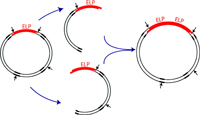| Title | Recursive Directional Ligation by Plasmid Reconstruction Allows Rapid and Seamless Cloning of Oligomeric Genes |
| Publication Type | Journal Article |
| Year of Publication | 2010 |
| Authors | McDaniel, JR, MacKay, JA, García Quiroz, F, Chilkoti, A |
| Journal | Biomacromolecules |
| Volume | 11 |
| Issue | 4 |
| Pagination | 944 - 952 |
| Date Published | 04/2010 |
| ISSN | 1526-4602 |
| Abstract | This paper reports a new strategy, recursive directional ligation by plasmid reconstruction (PRe-RDL), to rapidly clone highly repetitive polypeptides of any sequence and specified length over a large range of molecular weights. In a single cycle of PRe-RDL, two halves of a parent plasmid, each containing a copy of an oligomer, are ligated together, thereby dimerizing the oligomer and reconstituting a functional plasmid. This process is carried out recursively to assemble an oligomeric gene with the desired number of repeats. PRe-RDL has several unique features that stem from the use of type IIs restriction endonucleases: first, PRe-RDL is a seamless cloning method that leaves no extraneous nucleotides at the ligation junction. Because it uses type IIs endonucleases to ligate the two halves of the plasmid, PRe-RDL also addresses the major limitation of RDL in that it abolishes any restriction on the gene sequence that can be oligomerized. The reconstitution of a functional plasmid only upon successful ligation in PRe-RDL also addresses two other limitations of RDL: the significant background from self-ligation of the vector observed in RDL, and the decreased efficiency of ligation due to nonproductive circularization of the insert. PRe-RDL can also be used to assemble genes that encode different sequences in a predetermined order to encode block copolymers or append leader and trailer peptide sequences to the oligomerized gene. |
| DOI | 10.1021/bm901387t |
| Short Title | Biomacromolecules |
| Full Text |
